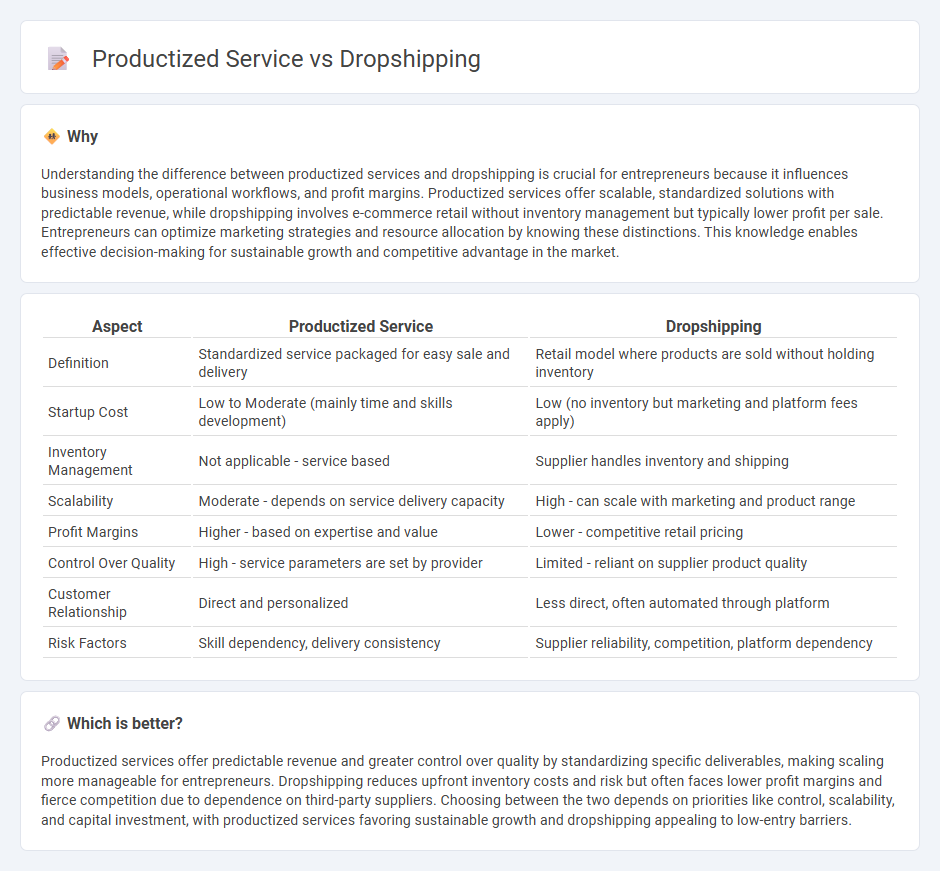
Productized services offer a scalable business model by standardizing service delivery with fixed pricing, ensuring consistent quality and predictable revenue streams. Dropshipping allows entrepreneurs to sell products without holding inventory, leveraging supplier networks to fulfill orders directly to customers, minimizing upfront costs and logistical complexities. Explore the distinct advantages and challenges of productized services and dropshipping to determine the best fit for your entrepreneurial goals.
Why it is important
Understanding the difference between productized services and dropshipping is crucial for entrepreneurs because it influences business models, operational workflows, and profit margins. Productized services offer scalable, standardized solutions with predictable revenue, while dropshipping involves e-commerce retail without inventory management but typically lower profit per sale. Entrepreneurs can optimize marketing strategies and resource allocation by knowing these distinctions. This knowledge enables effective decision-making for sustainable growth and competitive advantage in the market.
Comparison Table
| Aspect | Productized Service | Dropshipping |
|---|---|---|
| Definition | Standardized service packaged for easy sale and delivery | Retail model where products are sold without holding inventory |
| Startup Cost | Low to Moderate (mainly time and skills development) | Low (no inventory but marketing and platform fees apply) |
| Inventory Management | Not applicable - service based | Supplier handles inventory and shipping |
| Scalability | Moderate - depends on service delivery capacity | High - can scale with marketing and product range |
| Profit Margins | Higher - based on expertise and value | Lower - competitive retail pricing |
| Control Over Quality | High - service parameters are set by provider | Limited - reliant on supplier product quality |
| Customer Relationship | Direct and personalized | Less direct, often automated through platform |
| Risk Factors | Skill dependency, delivery consistency | Supplier reliability, competition, platform dependency |
Which is better?
Productized services offer predictable revenue and greater control over quality by standardizing specific deliverables, making scaling more manageable for entrepreneurs. Dropshipping reduces upfront inventory costs and risk but often faces lower profit margins and fierce competition due to dependence on third-party suppliers. Choosing between the two depends on priorities like control, scalability, and capital investment, with productized services favoring sustainable growth and dropshipping appealing to low-entry barriers.
Connection
Productized services and dropshipping both enable entrepreneurs to scale businesses with minimal inventory risk and streamlined operations. A productized service standardizes offerings into fixed packages, allowing entrepreneurs to automate and delegate tasks, while dropshipping eliminates the need for upfront stock by shipping products directly from suppliers to customers. Combining these models leverages automation and outsourcing, optimizing cash flow and operational efficiency in e-commerce ventures.
Key Terms
Inventory Management
Dropshipping minimizes inventory management by outsourcing stock handling to suppliers, reducing overhead and storage costs. Productized services eliminate physical inventory entirely, focusing on standardized service offerings that streamline operations and improve scalability. Explore detailed comparisons of inventory control benefits in dropshipping versus productized services to optimize your business model.
Scalability
Dropshipping offers scalability through automated inventory management and global supplier networks, enabling rapid market expansion without holding stock. Productized services scale by standardizing offerings, streamlining delivery processes, and leveraging skilled teams to handle increased demand efficiently. Explore deeper insights into scalability strategies for both models to enhance your business growth.
Customer Experience
Dropshipping often struggles with inconsistent shipping times and limited product control, affecting customer satisfaction and loyalty, whereas productized services offer standardized, predictable experiences that enhance trust and brand reputation. Delivering a seamless and personalized journey is easier with productized services due to direct interaction and tailored solutions, leading to higher customer retention rates. Explore how focusing on customer experience can transform your business strategy and boost long-term success.
Source and External Links
What Is Dropshipping and How Does It Work? - Wix.com - Dropshipping is a retail fulfillment model where the seller does not keep inventory but purchases products from a third-party supplier who ships them directly to the customer, with the retailer focusing on marketing and storefront management.
What Is Dropshipping and How Does It Work? (2025) - Shopify - Dropshipping involves partnering with suppliers who store and ship products directly to customers, while the retailer sets prices, markets products, and manages the online store, often using apps to automate order forwarding and product updates.
Drop shipping - Wikipedia - Drop shipping is a supply chain method where the retailer accepts orders without holding stock, forwarding orders and shipping details to suppliers who ship directly to customers, allowing low startup costs but less control over quality and shipping.
 dowidth.com
dowidth.com